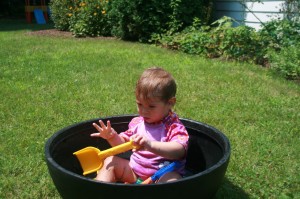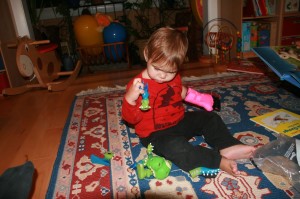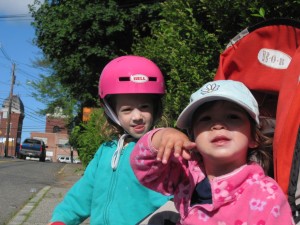This may be my longest post so far as part of my streak in the month of May to spread awareness about pediatric stroke. Please consider donating to support Children’s Hemiplegia and Stroke Association, an organization that has helped our family tremendously with support and information.
When Mia was nearly 12 months old, her physical therapist suggested that a splint might help her right thumb abduct better. She tended to keep it tucked in next to her hand. With my Feldenkrais orientation, I was really opposed to any kind of stretching for Mia’s right hand, wrist, or arm. I didn’t want to splint her right arm. From what I knew, that would only cause her brain to work harder against the resistance of the splint. So began a research project that led me to Children’s Hemiplegia and Stroke Association (CHASA) which helped me discover Constraint Induced Movement Therapy (CIMT), and make my own conclusions about what to try with Mia.
Here’s Mia on her first birthday, chewing on a watermelon rind that she’s holding with lefty. You can see that her right hand is in a fist and her right thumb is tucked in between her index finger and her middle finger. This was a common position for Mia at that age.
When Mia was first diagnosed, I think I did find CHASA but I didn’t want to sign on to the support group there. I don’t know if it was because I was in shock, denial, or just didn’t want to fully identify with the group. I was doing everything I could to ensure Mia’s recovery. In any case, after a year, I was on a mission to avoid the recommended splint for righty, and needed to search the archives of posts of other families who were dealing with similar challenges, similar decisions. I found many discussions of splints for the affected hand and also for the unaffected hand in the context of CIMT. So what is it?
Constraint Induced Movement Therapy is an approach where you restrict the movement of the unaffected hand and arm, usually through casting or splinting it, so the person is given the opportunity to learn to use the affected hand and arm, of necessity. Intensive therapy is given at the same time so progressively more challenging tasks can be mastered over a period of days or weeks. Often, significant improvement can be seen over an intensive period of a few weeks. This work was pioneered by Edward Taub in controversial research with monkeys but later accepted for adult stroke patients and more recently adapted for kids.
I found all the articles I could on pediatric CIMT, took them with me on vacation, read The Brain That Changes Itself, and went to the pharmacy for self-adhesive ace bandages to use to fashion my own constraint for Mia who was just starting to walk but still crawling quite a lot. I wanted a constraint that limited her ability to use her left fingers but allowed her to crawl and pull to standing. I covered the bandage with a sock. Mia’s vacation was spent with her left hand and wrist in this constraint for all her waking hours except if we went swimming. She played on the beach like that, she ate like that, she seemed to adapt.
Here she is at 12 months old, working hard to get a blueberry into her mouth.
I had some tough conversations with family members and strangers. Everyone wanted to know why I was taking away her “good hand.” Strangers wanted to express empathy that my baby had broken her arm. But, then if I replied that she’d had a stroke, they were in shock. I was learning too, dancing between sharing our truth, and just getting on with helping Mia. In that week, Mia gained some skill with her grasping and releasing. I brought out new toys and fun finger foods. Food is highly motivating so if she was successful in eating with righty, she’d keep at it.
Sometimes we took the wrap off because it was hot or annoying. Mia started to spontaneously open her hand a lot more to do things like grab a sand shovel while playing in water.
Over the next few months, I got more professional resources to help support our experiments. We saw a physiatrist, that is a doctor of rehabilitative medicine. She connected us with an occupational therapist who specialized in CIMT at Spaulding Rehabilitation Hospital. Another parent on the Hemi-Kids mailing list referred me to a fabulous orthotist who made a hot pink neoprene splint for Mia to wear on lefty.
Here’s Mia playing with a magnetic monster with righty and sporting her new splint on lefty. She was 15 months old.
Once we had that splint that was easy to put on and take off, we tried a new routine where the splint was just another thing that Mia had to put on each morning while getting dressed. She wore it from about 7 am until 10:30 am so she ate breakfast at home with righty and snack at daycare also with righty. I oriented her daycare teachers about good activities to do in the classroom – lots of sensory stuff like sand, rice, beans, water and shaving cream, puzzles, toys, balls.
Mia could point well with her right index finger by the age of 2 years.
The splints that Mia has had all stopped below the elbow so she could always do bimanual things too. That helped cut down on frustration. Mia eventually outgrew the pink splint and by then she was old enough to request her own color – green! By the time she was 2.5, she had developed both the ability to point and a decent pincer grasp. She had also developed the ability to take off her splint and she started to protest wearing it every day. So we stopped.
By then, Mia could respond to verbal prompts to, “Give righty a turn.” Or, “Use both hands.” Or, “High five with righty!” Try asking most 2-year-olds to do something with righty or lefty and they won’t know what you’re talking about. Typically, handedness doesn’t develop until age 3.
Here’s a video of Mia working hard to do a puzzle, she’s practicing her pincer grasp and doing a nice palmar grasp and working on supinating too, that is to rotate her arm so her palm is up.





